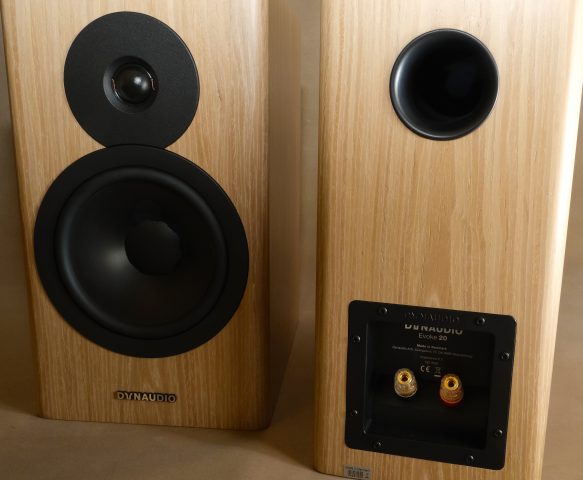DYNAUDIO EVOKE 20 standmount speakers
+ Clean, smooth sound without being overly dry nor analytical; good midrange presence with room-shaking bass.
– Conversely, bass limitation noticeable due to excellent presence slightly higher up.
Sound: 9/10
Value: 9/10
IT may arguably be easier to build a cost-no-object speaker than a mid-range model. Yes, there is great complexity involved and technical acumen needed to come up with true innovations in speaker design – but embodying the designer’s inspiration can be easier when unrestrained by limitations of cost.
A mid-range speaker, however, has to achieve a very high level of performance sonically, but it has to be manifested without breaking the bank. Top this off with the mid-range being one of the more competitive speaker segments and you have an idea of the challenges facing the Dynaudio Evoke 20.
This Danish-based manufacturer has an ace up its sleeve, though – a 40-year legacy of making speakers of distinction to fall back on. In the case of the Evoke range, it has filtered down technologies from its higher-end models into the design, and for all intents and purposes, Dynaudio has done a sterling job.

The Evoke 20 is a rather large bookshelf design that measures 380 x 215 x 307mm (h/w/d) and weighs 9.9kg. The cabinet has non-parallel side walls and tapers to a narrower back panel.
A two-way rear-ported design, it features an 18cm Esotec+ woofer and a 28mm Cerotar tweeter, with a single pair of hefty speaker posts at the back. Both drivers have rather elite pedigrees, though.
The entire woofer cone – including the dust cap – is crafted from a single piece from MSP (Magnesium Silicate Polymer), a proprietary material Dynaudio has been using for decades. It has a 52mm aluminium voice coil and a new strontium carbonate Ferrite+ ceramic magnet system.
The tweeter is an all-new design, with trickle-down technology from Dynaudio’s top-of-the-line Confidence speakers. Hidden behind its soft dome is something Dynaudio calls the Hexis – an inner dome that is supposed to aid air flow, smoothen frequency response and minimise resonances. The drivers work in tandem to give a frequency response of 40Hz-23kHz, with the crossover point at 3200Hz.

The fit and finish of the speaker are impeccable. It also looks really sharp with its clean and simple lines and a choice of four colours – Black High Gloss, White High Gloss, Walnut Wood and (the review sample’s) Blonde Wood.
A nice touch is how Dynaudio has protected the tweeter during transport. A magnetically-attached rubberised cap protects the entire dome, and coloured bright yellow, so you can’t possibly miss and forget to remove it before playing.
SETTING UP
The Evoke 20 will still require stands, and a pair of four-pillar 24-inch stands was used to that effect. Placement will be room-dependent, but wisdom dictates you should give it some room at the back since it is rear-ported.
In my rather narrow room, the Evoke 20s had about three-and-a-half feet of rear space and were as far from the side walls as possible (18 inches in my case) and about four feet apart. Some toe-in was applied so each speaker fired slightly off the side of each ear in my listening position about six feet away.
Generally, though, I found the Evoke 20s quite forgiving of placement and with a large sweet spot. Familiarity with where speakers sound best in my room aside, they sounded good from the get-go and only required minor adjustments to achieve better coherence.
LISTENING
Switching over from the resident Magnepan .7 speakers to the Evoke 20s, the stand-out difference was in the bass. Admittedly, bass is not the Magnepans’ forte, but the Evoke 20’s bottom-end grunt took me by surprise.
It just so happened I was listening to the 24-bit/44kHz version of The Beatles’ Abbey Road 1999 remaster (ahead of the remixed album’s 50th anniversary release) before switching speakers and the first few notes of Come Together gave me quite a surprise! There was plenty of weight behind it, prompting me to play the track a few more times at much louder volumes. A few loose objects began to rattle and the bass was felt right in the chest, things in my room started to rattle, yet the Evoke 20s retained superb control of the bass.

This got me seeking some heavier bass tracks and out came Daft Punk’s Random Access Memories, with a few other tracks from Katy Perry’s Prism and Sia’s This Is Acting thrown into the mix. The electronic synth bass from these tracks shook things up even more, but the Evokes remained steadfast. One drawback, though, was that they could not reach down to the really deep notes – particularly noticeable in a descending bass line. That said, the amount and depth of bass produced relative to these small boxes will be beyond what you’d expect.
Not everything is about bass – although they possess a visceral punch, the Evoke 20s are able to sound smooth and lush when the music calls for it. Playing pianist Arthur Rubinstein’s rendition of Chopin’s Nocturnes, the Evoke 20s superbly reproduced the maestro’s delicate touch and the crescendo swells in his performance. They acquitted themselves wonderfully with female vocals, too, with Carole King sounding ever-so-beguiling on her Tapestry album.
Also impressive was the Evoke 20s’ ability to throw a deep and wide soundstage. Phillipe Jordan’s Beethoven symphony cycle conducting the Vienna Symphony Orchestra was recorded in the legendary Musikverein, and the pair managed to throw a wonderfully spacious sound with great depth, height and width that extended way beyond the speakers.

What the Evoke 20s also displayed was an ability to smooth over even some less-than-ideal material. Case in point when I temporarily connected an iPhone playing material off Spotify – even at lower resolution, it did not sound overly compromised.
THE LAST WORD
There’s much to like about the Evoke 20s. The beguiling manner in which they unfold the layers of the music to reveal the hidden details without sounding overly-analytical is to me is the trademark of a high-end speaker.
The fact that you won’t have to break the bank to get a pair is only more reason why the Dynaudio Evoke 20 should remain high on your shortlist. Highly recommended.
Gear
Sources: Sony HAP-Z1ES HDD audio player; Technics SL1200 Mk3 turntable with Hana SL cartridge; triple 12AX7 tube-based phono stage with step-up transformer; Toshiba notebook running Windows 10 and jRiver Media Centre; M2Tech Young DAC; Chord Mojo DAC/headphone amp / Amplification: Odyssey Audio Tempest preamp; Odyssey Audio Kismet monoblocks / Speakers: Magnepan .7 / Cabling: DH Labs SilverSonic USB cable, Clear Day Double Shotgun speaker cables, an assortment of pure silver interconnects
Price: €2,000
Malaysian price: RM11,000
Malaysian distributor: CMY Audio & Visual Sdn Bhd (+603 2143-9406) / Find your distributor.






pimkie haut femme
Dynaudio Evoke 20 speakers – sweet Danish delight – audioFi.net
Unfortunately, the Chinese production is not controlled by Dynaudio. In mine, the resistance of the tweeter divider was different on each side and different from the factory value. 5.6 and 6.8, it should actually be 3.9.